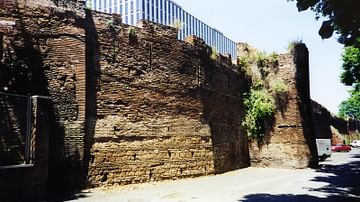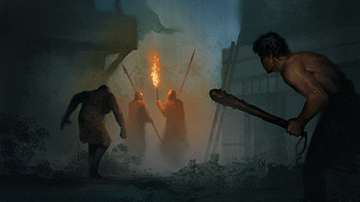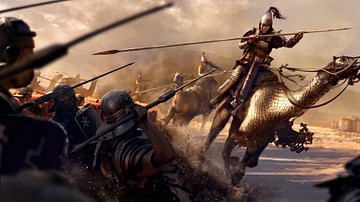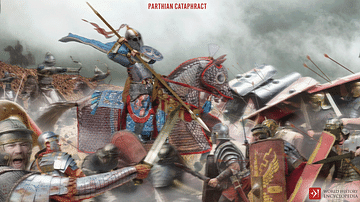
The Vigiles (or cohortes vigilum) were formed during the reign of Augustus to act as ancient Rome's permanent firefighting service. Evolving from earlier slave teams, the vigiles were organised as an urban military unit and eventually recruits came from the Roman citizenry. The body, with a permanent camp of its own and equipment stations dotted around the city, patrolled the streets of Rome each night and also performed certain nocturnal policing duties to ensure public order.
Evolution
The vigiles were created by Augustus in 6 CE to meet the high risk of fires in the capital presented by its high population density and widespread use of wooden housing and other buildings which had timber parts. It was not the first time such a force had been created for the avaricious Marcus Licinius Crassus, one of Rome's all-time richest men, had spotted the chance of making money by offering low prices for burning buildings and then having his team of slaves extinguish the fire so that it could be saved for redevelopment. If the property owner refused Crassus' offer, then the fire was left to rage on unabated.
The next step towards a proper fire service was taken by the aedile Egnatius Rufus who, like Crassus, created a force of slaves to put out fires but, unlike Crassus, seems to have been more motivated by issues of public safety. He may have sought political cachet from his creation, but it did not do him much good as the Senate later dealt him the death sentence for conspiring against the state. Another idea to protect the city, particularly at night, was the creation of the tresviri nocturni - three magistrates set on night watch. Yet again, this trio's workforce was composed of slaves, and it was their duty to prevent any disturbances in the city. Some wealthy private individuals even formed their own personal fire brigades, though, such was the need for a larger ever-present response team to fires.
C. 21 BCE Augustus took matters in hand and reorganised what was left of Rufus' slaves, creating a force of 600 slaves to fight fires if and when they arose. The aediles were put in charge of this new force, but they seem to have been ineffectual for, following serious fires in 7 BCE, Augustus reorganised them again. This time the force was split to cover 14 zones, each further divided into vici. Thus each of the 265 vici had its own designated group of firefighting public slaves commanded by the viciomagister. This was an improvement on the previous system, but there remained problems with coordination between different vici. This led to Augustus finally creating a single force, the vigiles.
Organisation & Duties
The vigiles were composed of freedmen, with officers coming from the army. They were organised into seven 1000-man cohorts (although perhaps initially only half this number), each led by an equestrian tribune. Each cohort was divided into seven units led by a centurion. The entire force was commanded by an equestrian prefect, the Praefectus Vigilum. In the reign of Tiberius (14-37 CE) the term of service for vigiles was set at six years, after which they could claim Roman citizenship. During the reign of Trajan (98-117 CE) the prefect was given a sub-prefect as his second-in-command. Eventually, the term of service in the vigiles was reduced to a mere three years and the force began to attract citizens leading to an expansion under Septimius Severus (r. 193-211 CE).
The 14 zones of the city of Rome were assigned so that each cohort was responsible for fires in two zones. The vigiles had their own camp built in the city while firefighting equipment was kept in each zone in a designated storage facility known as the excubitorium. Here too, a small number of the cohort was stationed on a permanent basis, presumably on rotation. The vigiles patrolled the city each night, literally earning their name and keeping a vigil for any outbreaks of fire. Another duty was to arrest anyone out on the streets at night and looking suspicious. Anyone arrested was taken to the city prefect, the commander of the city's urban cohorts, for judgement.
Although officers of the vigiles, particularly centurions and prefects, often rose to take on roles in the more prestigious urban cohorts and Praetorian Guard, Rome's other military organisations, Roman historians such as Tacitus did not consider the vigiles as fighting soldiers. Having said that, in the crises of the 69 CE and 193 CE civil wars, they did see military action. In the 4th century CE the vigiles were disbanded and replaced by specialised guilds responsible for firefighting.
FireFighting
As equipment was primitive and the only sure way to contain a fire was to demolish a building (and sometimes its neighbours to prevent the blaze spreading), the best action the vigiles could provide was to spot a fire before it took a real hold. Another preventative measure was to limit the height of the large tenant blocks in Rome, increase the space between buildings and the width of streets, and build firewalls.
If a serious fire did break out, then the vigiles had the following equipment at their disposal, which was also required by tenants to provide too: fire buckets (amae), sponges (spongiae), force-pumps (siphones), axes (dolabrae), picks (secures), ladders (scalae), grappling hooks (falces), quilted blankets (centones), wicker mats (formiones), poles (perticae), brooms (scopae) and vinegar. With these, they could douse the fire, smother it, and pull down parts of or all of the burning buildings.
Legacy
The ruins of the excubitorium of cohors VII can still be seen today in Rome near the bridge which crosses to the Tiber Island. Another excubitorium, that of the cohors V, is known to lie beneath the church of Santa Maria in Domnica, which was built in the 19th century CE. The idea of a permanent firefighting service spread to other Roman cities. Claudius (r. 41-54 CE) created two additional units of vigiles to safeguard Ostia and Puteoli, and other fire brigades are known at Carthage, Lyon, Ravenna, and Constantinople in Late Antiquity. The vigiles name also lives on in the city of Rome and across the country as Italy's fire and rescue service is today called the Vigili del Fuoco.










